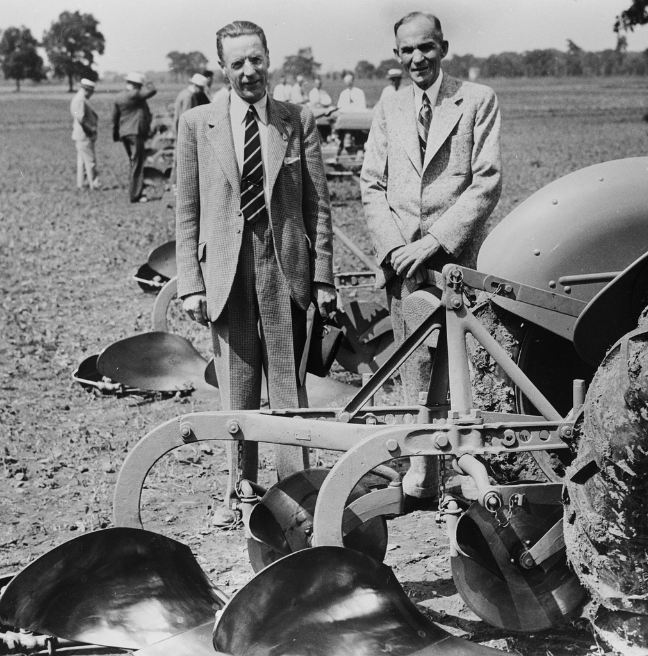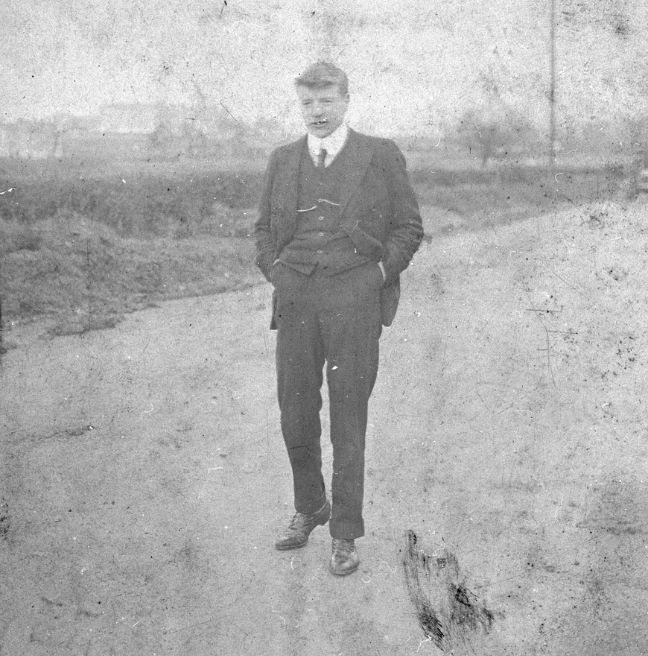
harry ferguson & agriculture: the early days
Find out how Harry Ferguson entered the world of agriculture with John Barron, Director of Friends of Ferguson Heritage.
The Plough
Harry Ferguson and his colleague Willie Sands were appointed by the Irish Board of Agriculture to improve the efficiency and output of tractor powered tillage during the spring of 1917.

The two men travelled the length and breadth of the tillage areas of Ireland and were appalled by the design, weight, and complexity of operation of the ploughs being used on the various farms that they visited.
Harry decided to design and build a plough for the very light Ford Eros tractor. By 1917 the plough, commonly called the Belfast plough was ready. This plough incorporated many novel features, was a major advance on prevailing technology and was only a third of the weight of other two furrow ploughs on the market.
However, the marketing was a disaster because of a change of strategy at Ford Motor company. This was because of the launch of the new Fordson tractor in North America, with the discontinuation of the Eros.
In the following years, Ferguson and his team continued to develop the invention for a Fordson F tractor. The first iteration was no more than an adapted version of the Eros design and simply hitched to the drawbar cap of the tractor. But the plough was not satisfactory from a weight, functionality or aesthetic perspective. The team continued to work on an improved design, the result being a beautifully engineered implement with a novel hitching arrangement called the Duplex hitch.

The hitch and plough were ready for production in 1919 to coincide with the beginning of production of the Fordson tractor at Fords new manufacturing facility in Cork. However, the plough was nowhere near the level of perfection that Ferguson desired or believed possible.
After a number of unsuccessful attempts to find appropriate distribution outlets in the USA failed, Ferguson eventually established a relationship with the Sherman brothers to form the Ferguson Sherman company, who were reasonably successful in marketing the implement despite obvious shortcomings.
Automatic Draft Control
With the plough business running reasonably smoothly, Ferguson and the team turned their attention to the concept of Automatic Draft Control.

The principle of this concept was simple in theory. The implement cutting through soil at a certain depth requires a certain force or draft to pull it. If the implement runs deeper or shallower than the preset depth, due to a change in soil consistency, the draft will increase or decrease. Ferguson's team asked the question “why not use that force to control all depth of work automatically”.
The draft forces are sensed through the points at which the implement is attached to the tractor and if there was a mechanism for raising or lowering the implement, it should be possible to have the mechanism activated automatically by changes of draft load. The first major patent was applied for in February of 1925.
This patent presented a number of options and more torturous work followed to prove and refine the concept. A number of arrangements were built onto the back of a Fordson tractor and eventually Ferguson asked his team to work on a system that could be fitted to a Fordson tractor.
No sooner had technical success been achieved when in 1928 Ferguson decided to abandon the tractor market in North America and ceased production there. What became known as the Ferguson system was gradually taking shape, but it was far from being a commercially viable proposition. Work continued using the system externally on the Fordson. When eventually the Black Tractor was being developed, the system was positioned internally.
The Dream Team
By 1932 the Ferguson team that included Willie Sands and Archie Greer had formulated their ideas and once the general architecture was sketched a high-quality draughtsman, John Chambers, was recruited into the core team.

Components were acquired from several sources: steering box, transmission and rear axle from David Brown and the power unit from the Hercules Corporation in the USA. Many other components were sourced in Northern Ireland, some from local forges, more complicated castings from companies such as Harland and Wolf and Short Brothers, with many machined parts being produced at Fergusons’ May Street premises.
As testing progressed from 1933 into 1934 test results were disappointing and two issues deserve special mention. The first was known as the “bobbing” effect whereby in certain soil conditions an uneven furrow bottom was created. This was solved brilliantly by Willie Sands by moving the compression load of the automatic draft control from the lower links to the top link. The second was the tendency of the hydraulic oil to heat and aerate, this was solved by Ferguson in a eureka moment by developing what came to be known as Side Suction Control (SSC).
By 1935 almost all the problems were resolved and arguably the most important tractor that the world has ever known-the Black tractor was created. In 1936 the tractor went into production in the David Brown Park works in Huddersfield and and was designated the Ferguson Type A during its production run between 1933 and 1936, but was more commonly called the Ferguson Brown.
Harry Ferguson was well on his way to inventing the tractor that would transform the agriculture industry.
LEARN MORE
Harry Ferguson & Agriculture: The Later Years
Return to Harry Ferguson's world of agriculture with John Barron, Director of Friends of Ferguson Heritage.
Harry Ferguson & Aviation
Harry Ferguson is famous for his pioneering innovations in the world of agriculture, but his earliest achievements were in aviation.
The Life and Legacy of Harry Ferguson
Explore the life and worldwide impact of Innovator Harry Ferguson with John Barron, Director of Friends of Ferguson Heritage.


